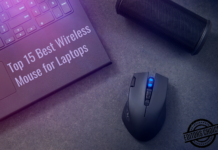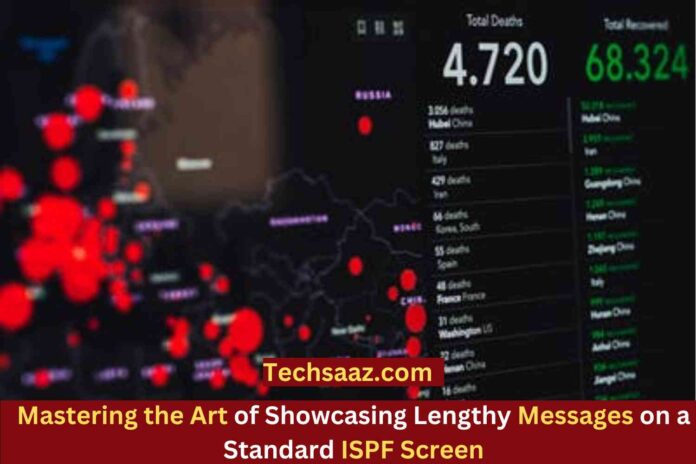A robust software program called the Interactive System Productivity Facility (ISPF) gives mainframe computer systems an appealing user interface. Users may interface with system resources, change files, and submit jobs, among other things, thanks to this tool. The accurate display of messages, especially lengthy ones that may surpass the conventional screen size, is essential to utilize ISPF efficiently.

The Importance of Efficiently Showing Lengthy Texts
Messages act as a communication channel between the system and the user in the context of ISPF. Important information is sent by these messages, such as problem alerts, status updates, or requests for user interaction. However, dealing with lengthy communications presents many difficulties.
Usability and Readability:
Long messages might be difficult to read and understand, particularly if they fill the visible screen. Users could find it challenging to comprehend the entire message if it needs to be shown correctly, which might cause misunderstanding, mistakes, or dissatisfaction. As a result, it’s crucial to make sure that lengthy messages are displayed in a manner that encourages reading and improves the user experience as a whole.
Accuracy of Information:
Long messages often provide critical information that users need to take the right actions or make informed judgments. Users risk missing crucial information if the message is truncated or chopped off on the screen owing to space restrictions.
Effectively displaying lengthy messages ensures that consumers get the full statement, allowing them to comprehend the issue and react appropriately completely. Let’s now discuss “Mastering the Art of Showcasing Lengthy Messages on a Standard ISPF Screen.”
Productivity and Efficiency
The productivity of users may be significantly increased by processing lengthy texts well. Users can make rapid judgments, offer correct input, and complete jobs without needless delays when they can quickly read and comprehend extensive texts. In contrast, if lengthy messages are not efficiently shown, users may spend more time attempting to understand or navigate through the letter, diminishing efficiency.
To overcome these issues, it is essential to use methods that efficiently display lengthy messages within the constraints of the typical ISPF screen. Using the right tactics, users may get comprehensive and simple-to-read notifications, enhancing their engagement with ISPF and boosting overall productivity.
The following sections will examine several methods for showing lengthy messages on a typical ISPF screen. These methods include employing pagination to divide messages into smaller chunks, scrolling inside the screen, increasing the screen size, adding message pop-ups, and putting message splitting and wrapping into practice. We will also go through the best ways to show lengthy notes succinctly, including how to utilize clear, short language, provide context and pertinent details, and provide navigation choices and user controls.
Users may overcome the difficulties of lengthy messages and guarantee a seamless and practical user experience inside the ISPF environment by comprehending and implementing these strategies and best practices.
Remember to modify the content’s length and tone to match your chosen word count and writing style.Let’s now discuss “Mastering the Art of Showcasing Lengthy Messages on a Standard ISPF Screen.”
Table of Contents
Knowing ISPF Screen Restrictions
It’s critical to be aware of the limitations imposed by the maximum message length and the screen size while using ISPF. The quantity of data that may be shown at any one moment is often limited by the fixed rows and columns of the conventional ISPF screen.
Screen Size Restriction
ISPF displays typically have 24 rows and 80 columns, which leaves little room for information display. Due to the limited screen of real estate, messages that are longer than the allowed length cannot be shown in their entirety. Implementing strategies that enable users to obtain the exclusive content of lengthy communications without losing readability is thus crucial.
Longest Possible Message
The length of each message that may be shown is likewise limited by ISPF. The maximum size may change based on the system’s setup, although it is typically chosen to guarantee compatibility and top performance. Overriding it could cause unexpected behavior or message truncation.
Effects of lengthy messages on user experience and readability
The readability and general user experience inside ISPF may be significantly impacted by long messages longer than the typical screen size. Longer material presents several difficulties:
Readability:
Long texts crammed into a small screen may be difficult to read. It could be hard for consumers to follow the information’s flow if the content seems crowded. Users may need to pay more attention to crucial information or understand the message when readability could be improved, resulting in confusion and possible action mistakes.
Understanding and Memory:
Long communications make it harder for people to understand and remember what is said. When too much information is given at once, cognitive overload may happen. Users could find it challenging to comprehend the message clearly, which would reduce comprehension and retention of important information.
The Context and Navigation:
Users may need to scroll through lengthy messages to obtain all the information. This laborious and time-consuming scrolling movement might interrupt the flow of work. Additionally, more than scrolling alone may be required to provide people with the context they need to comprehend the content entirely. A lack of relevant context may hamper users’ capacity to make informed judgments or take appropriate action.
Various methods and best practices may be used to address these issues, improve readability, and improve user experience. These include using pagination to divide lengthy messages into manageable chunks, adding scrolling capabilities to the ISPF screen, enlarging the screen to accommodate more material, using message pop-ups for further details, and leveraging message splitting and wrapping methods.
Understanding the restrictions imposed by ISPF displays and admitting the adverse effects of lengthy messages on readability and user experience allow us to consider practical solutions to these restrictions. We will go into these strategies in further depth in the following sections, offering explanations and pointers on how to show lengthy messages successfully in the ISPF environment.
Remember to modify the content’s length and tone to match your chosen word count and writing style. Let’s now discuss “Mastering the Art of Showcasing Lengthy Messages on a Standard ISPF Screen.”
Long message presentation methods
Getting started with pagination
Using the pagination approach, long communications may be broken into pages or smaller, more digestible pieces. Users may move between the message’s components using page indications or commands rather than having the complete message shown at once.
When dealing with long messages, using pagination, ISPF may significantly enhance the user experience and readability. Users may concentrate on one aspect of the announcement at a time by dividing the material into manageable pieces, reducing cognitive overload and making it simpler to absorb the information provided.
Choosing the correct page size and navigation choices
When using pagination, it’s critical to select a page size that balances showing enough material on each page with preventing unnecessary scrolling. The page size should consider the average message length and the amount of screen real estate.
It’s also critical to provide simple navigation alternatives. Users should easily navigate between pages and comprehend where they are concerning the overall message. Using commands like “Next Page” and “Previous Page,” as well as showing page numbers or progress indicators, are standard navigational techniques.
Inside the ISPF Screen, Scrolling
Utilizing vertical scrolling
Users may go up and down the text using vertical scrolling to see the complete content of a lengthy message. Since ISPF allows for vertical scrolling, large messages may be read without being expressly divided into smaller pages.
Developers should check that the ISPF screen is set up to allow vertical scrolling before turning it on. Users may move vertically inside the message using the arrow keys or standard scrolling controls.
scrolling horizontally for broad texts
When dealing with messages bigger than the default screen width, horizontal scrolling is just as necessary as vertical scrolling. Tables, graphs, and other prepared material that cannot be presented adequately in the constrained 80-column area may be included in broad messages.
Users of ISPF may scroll horizontally to see the whole document. To do this, either enables horizontal scroll bars or use instructions to move the viewable part of the message to the left or right.
The Enlargement of the Screen
Changing the ISPF’s default settings
By altering the ISPF settings to increase the screen size, lengthier messages may be shown more efficiently. While the standard ISPF screen includes 24 rows and 80 columns, these numbers may be changed depending on the user’s tastes or needs.
Users may change the settings on their terminal to increase the number of accessible rows and columns, creating a more comprehensive display area. Before making substantial modifications to the screen size, it is crucial to consider the terminal’s capabilities and ensure they are compatible.
maximizing the space on the screen that is available
Developers may use every pixel of open screen space without changing the screen size via modification. ISPF apps should have a simple, clutter-free user interface to avoid wasting space. This will allow users to show lengthy messages without scrolling down the screen.
Users may benefit from a better user experience when dealing with lengthy messages without significantly modifying their terminal settings by optimizing the layout and effectively using screen space.
Using pop-up messages
Overview of pop-up windows
Message pop-ups are brief windows that sometimes appear on the primary ISPF screen to show more information. Users’ activities, such as clicking on a link or lingering over a particular piece, may cause these pop-ups to appear.
Pop-up windows may be helpful when dealing with lengthy material since they can provide consumers with more information without interfering with their present context. They allow users to obtain additional in-depth justifications, illustrations, or directions without leaving the home screen.
Use pop-up notifications for lengthy content.
Developers may use different methods to implement pop-up messages in ISPF. This may include utilizing customized pop-up ISPF dialog boxes or panels or employing dynamic pop-up windows using ISPF programming tools.
To stand out from the material on the main screen, pop-up messages should be formatted appropriately. This will help ensure that they attract the user’s attention without intruding. Additionally, they must provide simple navigation choices for closing or dismissing the pop-up and returning to the main interface.
Using message wrapping and splitting
Creating many lines for significant texts
Long messages are divided into numerous lines to fit on the available real estate screen. By using this method, the complete news is accessible without the need for panning or scrolling.
By manually adding line breaks at appropriate locations within the material, developers may manually separate messages. Additionally, using automated algorithms or formatting procedures, communications may be intelligently divided depending on elements like word boundaries or logical breaks in the text.
handling truncation and wrapping
It’s critical to manage wrapping and truncation when dividing messages appropriately. Wrapping ensures that words are manageable over lines and keeps the content readable. Contrarily, truncation entails stopping the announcement at a predetermined length if it exceeds the available space.
Developers may ensure that lengthy messages are delivered visually attractively while preserving the integrity of the information by implementing appropriate wrapping methods and managing truncation appropriately.
Finally, implementing these strategies in the ISPF environment may significantly improve readability, user experience, and productivity. Developers can ensure users can access all the information they need without compromising clarity or usability by using pagination, scrolling options, customizing screen size, pop-up messages, or message splitting and wrapping.
Remember to modify the content’s length and tone to match your chosen word count and writing style.
Recommended Techniques for Long Message Display
It’s essential to use clear, simple language when showing lengthy messages. Users may need clarification on long messages that are verbose or include extraneous information, making it challenging to understand the core idea or take the necessary action.
Take into account the following recommended practices to increase readability and clarity:
Use simple language to avoid jargon or complex phrases that not everyone will understand. To successfully communicate, use straightforward, ordinary language.
Divide complicated ideas into manageable chunks: If the communication includes complex information or instructions, break them into more manageable parts. For easier scanning, use bullet points or numbered lists.
To grab attention, emphasize the message’s vital elements by choosing the most crucial details or activities. The main points may be separated into distinct sections, used in bold or italicized language, or in a different font size or color.
Providing background and pertinent data
Providing extra context or supporting information may be necessary to ensure that people comprehend a message and its ramifications. Users could find it challenging to make wise judgments or take the right actions without the relevant context.
The following are some excellent practices to keep in mind while giving context:
Give a summary or introduction: State the message’s objective or critical point in a concise summary or opening at the outset. Thanks to this, users can swiftly understand the message’s importance before learning more.
If the message refers to specific data, records, or past user activities, offer references or hyperlinks to make them easier to find. Users may do this without leaving the message’s context and evaluating the pertinent data.
Give users clear guidance on responding to the message by including actionable instructions. Use clear, simple language to direct people toward their intended actions.
Providing user controls and navigation choices
Long messages may be intimidating for consumers, especially if they must travel through them to get the material. Long messages may be simpler to engage with if navigational options and user controls are available.
Take into account the navigating guidelines and user controls listed below:
If the message has to be scrolled, display a scrollbar or progress indication to let people know where they are concerning the statement. Users might use this as a visual signal indicating the availability of material.
If the message is divided into pages or parts, clearly mark each one and provide simple navigation instructions. Users may navigate the information quickly using commands like “Next Page,” “Previous Page,” or numbered page markers.
Section collapse or expansion: If the message has portions that can be collapsed or expanded, provide controls so that users may do so. This reduces visual clutter and aids users in concentrating on specific aspects of the content.
Users may explore and engage with lengthy messages by implementing these best practices. Clear and concise wording ensures the message is readily comprehended; context and practical information boost understanding, and the availability of navigation choices and user controls enhances the user experience overall.
Remember to modify the content’s length and tone to match your chosen word count and writing style. Let’s now discuss “Mastering the Art of Showcasing Lengthy Messages on a Standard ISPF Screen.”
Feedback and Testing
It is crucial to test the display of lengthy letters to make sure that the strategies and best practices put into place are efficient and provide a satisfying user experience. Before the system or program is made available to users, you may find and fix any problems through extensive testing. Think about the following testing components:
Readability and comprehension: Examine how consumers can grasp and digest the material to determine the readability of lengthy communications. Examine elements, including font size, layout, and word choice. To evaluate the readability of various user profiles, employ a broad set of users with varying degrees of system knowledge.
Check out the user controls and navigation choices offered for lengthy communications. Ensure users can easily navigate the material, get more information, and do necessary tasks. Analyze the efficiency of additional methods to show verbose messages, such as scrolling, pagination, pop-up windows, etc.
Cross-platform compatibility:
- Check how long messages appear on various platforms and gadgets.
- Make the formatting, layout, and usability constant and functional across multiple screen sizes, resolutions, and operating systems.
- Consider testing on desktops, laptops, tablets, and mobile devices to cover different user situations.
Collecting User Opinions
User feedback is essential to understand how effectively displaying lengthy messages fully satisfies user requirements and expectations. You may learn more about consumers’ experiences, spot any usability or pain spots, and make informed adjustments by asking for their input. Take into account the following techniques for getting user feedback:
Create user surveys or quizzes with the express purpose of gathering feedback on the presentation of lengthy messages. Inquire of users on their understanding, navigational simplicity, and general happiness with the message display strategies used. Allow users to provide detailed criticisms or recommendations for improvement.
User interviews and usability testing:
- Interview or test the usability of a sample of users one-on-one.
- After seeing how they respond with lengthy communications, ask them for their ideas, comments, and recommendations.
- Please pay close attention to any challenges they face or instances when they show perplexity or dissatisfaction.
Analytics and user behavior tracking: Use these techniques to get quantitative information on how people interact with lengthy communications. Analyze user interaction patterns or data like scroll depth or time spent on the message. This information may provide light on potential trouble spots or user engagement issues.
Encourage users to offer feedback via designated channels, such as online forums, help tickets, or feedback forms, by implementing support systems and feedback channels. Regularly check these channels and quickly reply to user comments. This indicates a dedication to resolving user issues and consistently enhancing the experience of viewing extended messages.
You may find areas for improvement and iteratively improve the presentation of lengthy messages by actively seeking out and listening to user input. Ensure your development cycle regularly considers user input to ensure your approaches meet user needs and provide the best possible user experience.
Remember to modify the content’s length and tone to match your chosen word count and writing style.
VI. Conclusion
A recap of successful methods for showing lengthy texts
In this post, we looked at many ways to efficiently display long messages in an ISPF context. Let’s review these methods:
Message segmentation: Using pagination, long messages may be broken into digestible chunks that readers can quickly go through.
Within the ISPF panel, users may scroll vertically to see lengthy messages’ exclusive contents without utilizing pagination. Horizontal scrolling may also be used for long messages that fill the whole screen.
Increasing the screen size: Users may have more room to show lengthy messages by adjusting the ISPF settings or making the most of the available screen space.
Using message pop-ups: Pop-up windows provide more information without interfering with the context of the main screen, enabling users to obtain more information as required.
We use message splitting and wrapping to guarantee that the information is shown effectively within the given space by breaking important notifications into many lines and managing wrapping and truncation.
B. urging the Use of best practices to improve user experience
The user experience while presenting lengthy messages inside the ISPF environment may be significantly improved by implementing the recommended practices outlined in this article. By adhering to these guidelines, developers may guarantee clear and succinct language, give navigation choices and user controls, and provide appropriate context and information. Let’s review the ideal procedures:
Clear and concise wording:
- Long communications are easier to read and grasp when written in simple terms.
- Complicated ideas are broken down.
- Crucial points are highlighted.
Including summaries or introductions, citing pertinent facts or activities, and providing directions that readers may follow can assist them in understanding the meaning and consequences of lengthy communications.
Offering navigation choices and user controls: Users can traverse and engage with lengthy messages more successfully when scrollbars, progress indicators, clear navigation instructions, collapsible sections, and expand/collapse buttons are used.
Developers may guarantee that lengthy messages are presented user-friendly, lowering cognitive load, enhancing understanding, and promoting effective decision-making and action-taking using these best practices.
In conclusion, successfully displaying lengthy texts on typical ISPF displays is crucial for users to have a good experience while obtaining vital information or instructions. Developers can optimize the display of long messages and improve the overall usability of their ISPF applications by utilizing techniques like pagination, scrolling, screen expansion, pop-up messages, and message splitting, as well as best practices for precise wording, proper context, and user-friendly controls.
Remember to modify the content’s length and tone to match your chosen word count and writing style.




























![4 Ways to Hack a WiFi Password on Android in 2023 [No Root] TechSaaz - how to hack a wifi password on android](https://www.techsaaz.com/wp-content/uploads/2019/08/how-to-hack-wifi-on-android-100x70.jpg)


